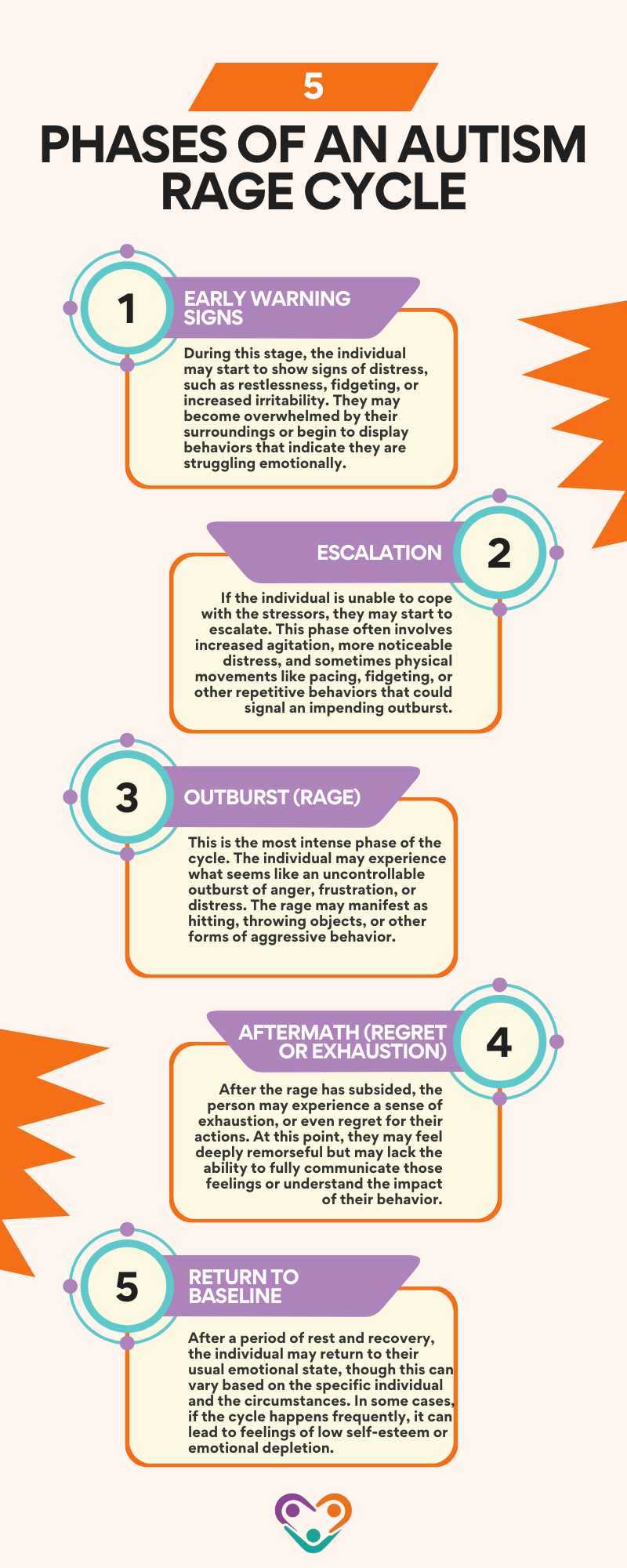
Table of Contents
The autism rage cycle can feel like a whirlwind – intense, overwhelming, and difficult to navigate. For those who experience it, as well as for their families and caregivers, understanding the patterns behind these emotional storms can make a world of difference.
It’s important to remember that this cycle isn’t about bad behavior; it’s a complex response to sensory overload, communication struggles, or unmet needs. By recognizing the signs early and knowing how to respond, you can help reduce the intensity and frequency of these episodes, creating a calmer, more supportive environment.
Let’s explore what causes these rage cycles and how you can better manage them.
What is Autism Rage?
Autism rage, sometimes referred to as autistic meltdowns or outbursts, is a manifestation of intense emotional reactions that individuals with autism may exhibit.
Contrary to the typical understanding of anger, autism rage is often a response to sensory overload, communication difficulties, or challenges in processing emotions.
These outbursts can vary in intensity, ranging from mild frustration to severe meltdowns characterized by screaming, crying, or physical aggression. It is crucial to recognize that autism rage is not a deliberate choice but a result of overwhelming sensory stimuli or difficulties in expressing emotions effectively.
Identifying the triggers and patterns associated with the autism rage cycle is instrumental in preempting and managing these outbursts. Triggers can be diverse and may include sensory sensitivities, changes in routine, communication breakdowns, or heightened emotional states.
Understanding the individualized triggers for each person with autism is key to developing effective strategies for prevention and intervention. By recognizing the patterns preceding an outburst, caregivers and individuals with autism can work together to implement coping mechanisms and communication tools to mitigate the impact of the rage cycle.
Understanding the Autism Rage Cycle
The autism rage cycle refers to a pattern of emotional and behavioral escalation that often leads to intense outbursts, anger, or even violent behavior. These outbursts are not random or an act of defiance; they are typically rooted in sensory overload, communication difficulties, or an inability to cope with changes in routine or environment.
The cycle itself can vary in length and intensity from person to person, but it generally follows a predictable progression.
An autism rage cycle typically consists of several phases that build up to an emotional explosion and can often lead to feelings of regret or exhaustion afterward. The cycle includes the following phases:

Impact on Individuals with Autism
Individuals with autism often face significant challenges related to emotional regulation and behavioral outbursts. Understanding these aspects is crucial in providing effective support and care.
Many individuals with autism experience difficulties in regulating their emotions. This can manifest in various ways, including heightened sensitivity to sensory stimuli, difficulties in identifying and expressing emotions, and challenges in understanding social cues.
As a result, individuals with autism may struggle to navigate complex or overwhelming emotional situations, leading to feelings of frustration, anxiety, or distress.
Behavioral outbursts, also known as meltdowns, are also common among individuals with autism. These outbursts are often triggered by overwhelming emotions, sensory overload, changes in routine, or communication difficulties.
During a meltdown, individuals may exhibit behaviors such as crying, yelling, hitting themselves or others, or engaging in repetitive movements. It is essential to recognize the signs leading up to a meltdown and implement strategies to help individuals regulate their emotions and cope with distress.
Understanding and addressing the emotional regulation challenges and behavioral outbursts faced by individuals with autism is fundamental to creating a supportive and inclusive environment that promotes their well-being and enhances their quality of life.
Managing and Reducing the Autism Rage Cycle
While the autism rage cycle can be challenging to manage, some strategies can help reduce its occurrence and provide the individual with better tools for managing their emotions.

Early Detection and Prevention
Recognizing the early warning signs of escalation is key to managing the rage cycle. If a person is showing signs of restlessness, agitation, or discomfort, it’s important to intervene early.
Offering a calm and safe environment, reducing sensory stimuli, or providing reassurance can prevent the cycle from progressing to an outburst.
One way to do this is by offering sensory breaks or providing comforting activities (such as a quiet space, sensory toys, or deep pressure) when signs of stress appear. Identifying patterns in behavior over time can also help in predicting when an outburst is likely to occur, allowing for proactive steps to prevent it.
Communication Support
Improving communication skills can significantly reduce frustration and emotional outbursts. For non-verbal individuals, using alternative forms of communication, such as sign language, picture communication systems (PECS), or communication devices, can help them express their needs more effectively.
For those who are verbal, teaching self-regulation strategies and giving them tools to better communicate feelings can alleviate the intensity of the rage cycle.
Sensory Regulation
Providing sensory accommodations that fit the individual’s sensory profile can help prevent overload. This might include controlling the sensory environment by adjusting lighting, sounds, or textures, or giving the person access to sensory tools, like fidget spinners, noise-canceling headphones, or weighted blankets. Predictable routines can also minimize stress caused by sensory overload or disorientation.
Managing Transitions and Routine Changes
Helping an individual with autism better cope with changes in routine can reduce anxiety and frustration.
Visual schedules, social stories, or clear verbal explanations about what to expect can ease transitions. Predictability helps reduce anxiety, and by preparing the person in advance for changes, they are less likely to feel overwhelmed.

Therapeutic Interventions
Behavioral therapies such as Applied Behavior Analysis (ABA) or Cognitive Behavioral Therapy (CBT) can provide valuable tools for managing emotional regulation. Therapy can help teach coping strategies, relaxation techniques, and other methods for reducing stress and anxiety. In addition, working with a therapist who specializes in autism can help identify the root causes of outbursts and provide personalized solutions.
Conclusion
The autism rage cycle is a complex and sometimes overwhelming experience for both individuals on the autism spectrum and those who care for them. Understanding the underlying causes can help in providing the right interventions and support.
With time, patience, and appropriate strategies, individuals on the autism spectrum can learn to navigate their emotions more effectively, leading to a better quality of life. At Golden Care Therapy, we offer expert ABA therapy in Georgia designed to meet the unique needs of each individual.
We are committed to providing compassionate and evidence-based support to help your loved one thrive. Contact us today to learn how we can help your family.
Sources:
- The Connection Between Autism and Mood Disorders - October 22, 2024
- Autistic Shutdown vs Depression: How They Differ - October 22, 2024
- Does ADHD Cause Procrastination? - October 22, 2024
